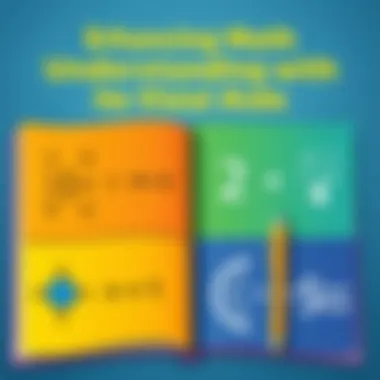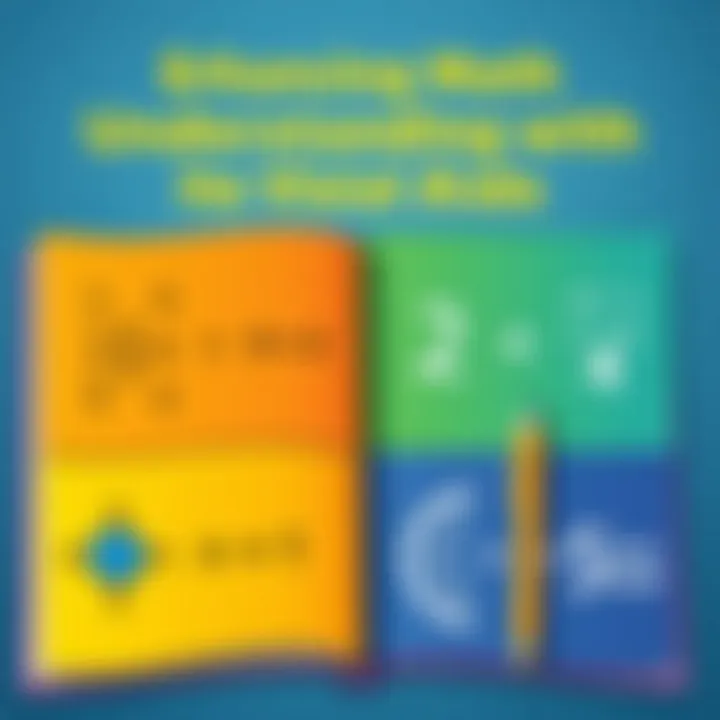Effective Strategies to Simplify Math Challenges


Intro
Creative Activities
Introducing creative activities into math learning can make complex ideas much more accessible. Practical engagement often serves as a catalyst for comprehension, and here are some ways through which young learners can connect with math:
Craft Ideas
Craft projects can visually demonstrate math concepts. Here are a few hands-on ideas:
- Paper Plate Fractions: Kids can use different colored paper plates to create fraction representations. Cutting plates into halves, quarters, or thirds helps visualize fractions.
- Geometry with Shapes: Using cut-out shapes, children can build polygons. This not only reinforces geometric concepts but also enhances spatial awareness.
Step-by-Step Guides
For each of these activities, clear step-by-step instructions can guide children through the process:
- Paper Plate Fractions:
- Building Shapes:
- Start with a plain paper plate.
- Use a pencil to mark fractions (for example, 1/2).
- Cut the plate into segments according to the markings.
- Color each segment differently to visually distinguish between the fractions.
- Collect various paper shapes: circles, squares, triangles.
- Provide glue and a baseboard for assembling.
- Challenge children to form specific geometric figures and discuss properties as they build.
Educational Value
Engaging in these creative activities helps solidify math concepts in a fun way. By crafting, children not only learn math but also develop fine motor skills and creativity. Also, they gain confidence in explaining their projects, reinforcing their understanding of math.
Fun Quizzes
To supplement the learning experience, interactive fun quizzes can help reinforce knowledge.
Quiz Topics
These quizzes can cover a range of topics such as:
- Basic arithmetic operations
- Understanding shapes
- Word problems
- Introduction to fractions
Question Types
Various question formats are important in keeping students engaged:
- Multiple-choice questions allow for trial and error, giving students the freedom to explore.
- Fill-in-the-blank questions challenge learners to recall information without prompts.
- True or false questions promote critical thinking as students assess statements.
Knowledge Reinforcement
By taking these quizzes, children reinforce what they have learned in a pressure-free context. It allows them to see instant feedback, thereby motivating them to improve further.
Fact-Based Articles
Supplemental reading can enrich a child’s understanding of math through fact-based articles.
Topics
Articles can offer insights on diverse subjects:
- The history of numbers
- The role of math in nature
- Famous mathematicians and their contributions
Engaging Content
Good articles break down complex information into digestible pieces. Incorporating illustrations or real-life examples keeps the content relatable and engaging, keeping young readers hooked.
Prelims to Simplifying Math
Mathematics can often feel like navigating a maze, especially for young learners. This article seeks to break that maze down into manageable pathways by introducing strategies that simplify math problems. Simplification isn’t just about finding the answer; it’s about understanding the underlying concepts, making the process smoother and more approachable. By honing these skills, students can develop confidence and tackle even the trickiest math problems.
Effective strategies enhance comprehension, making math not just a subject, but a tool for the future. Through various techniques like simplifying fractions or breaking down word problems, students get to experience success at every step. Regardless of individual learning styles or preferences, fostering such skills prepares students to face challenges in mathematics, ensuring they are well-equipped for both academic and real-world applications.
Understanding the Importance of Simplification
Simplification in math transforms complex problems into simpler ones. It's not simply about reducing numbers; it is about clarifying thought processes. When students learn to simplify, they learn to approach problems logically and systematically. This skill is crucial because:
- It prevents overwhelm. When faced with a challenging equation, breaking it down can make it less daunting.
- It aids retention. Concepts understood through simplification stick better than ones memorized mechanically.
- It builds resilience. Students learn that even tough problems can be manageable if approached step-by-step.


By mastering simplification, students lay a solid foundation for more advanced mathematical concepts, equipping them for future studies and problem-solving tasks.
Overview of Common Challenges in Math
Math is not without its hurdles. For many students, challenges in math can stem from different sources:
- Terminology: Mathematical language can be confusing. For instance, understanding what a ‘denominator’ is versus a ‘numerator’ can trip up young learners.
- Abstract Concepts: Some ideas, like variables in algebra, may seem distant from everyday experiences, creating a barrier to understanding.
- Fear of Mistakes: Many students are afraid of getting the wrong answer. This anxiety can hamper their willingness to engage with challenging problems.
- Instructional Gaps: If fundamental principles are not well understood, it can create a domino effect, leading to more complex errors as lessons progress.
Recognizing these challenges is the first step towards combating them. Addressing these issues through effective strategies not only aids in problem-solving but also nurtures a positive attitude towards learning math.
Basic Principles of Math
Understanding the basic principles of math is akin to laying a strong foundation for a house. These principles are essential for tackling more intricate problems down the line. This section addresses the core ideas that underpin arithmetic and algebra, highlighting their significance as it helps students simplify problems they confront in their mathematical journey.
Key Concepts in Arithmetic
Arithmetic is the most fundamental branch of mathematics. It includes operations like addition, subtraction, multiplication, and division. By grasping these basic concepts, students can enhance their numerical literacy. Here are some key points to consider:
- Addition and Subtraction: These are the building blocks of arithmetic. Understanding how to combine and separate numbers ensures that students can handle larger equations with ease.
- Multiplication and Division: As students move forward, they encounter larger numbers. Mastering these operations facilitates quicker calculations and greater confidence when approaching word problems.
- Place Value: Recognizing the value of digits based on their position in a number is crucial. This knowledge allows learners to understand larger numbers and their significance effectively.
- Patterns and Relationships: Encouraging students to observe patterns in numbers aids in recognizing relationships between different calculations, making it easier to solve complex problems.
Incorporating these concepts into regular practice can be beneficial. Students can use flashcards or mobile apps to reinforce these skills.
Introducing Algebraic Fundamentals
Algebra can seem daunting for many students, but it does not have to be. Introducing algebraic fundamentals early helps demystify this subject. Here are some essential components:
- Variables and Constants: Understanding the distinction between variables (like x or y) and constants (numbers like 5 or -3) is foundational. These elements serve as the crux of algebraic expressions and equations.
- Equations and Inequalities: Grasping how to formulate and solve equations allows students to tackle a variety of math problems. Equations illustrate relationships, while inequalities introduce concepts of comparison.
- Terms and Coefficients: Identifying terms in an expression and recognizing coefficients becomes easier with practice. This knowledge helps simplify algebraic expressions when students need to combine like terms.
- Functions: Familiarity with functions prepares students to understand more complex relationships between quantities when they advance in mathematics.
By integrating algebraic fundamentals into math lessons, educators can help students demystify and simplify complex concepts, paving the way for deeper understanding as they advance through their math education.
"The key to being good at math is not just getting the right answer but knowing how to approach different problems and simplify them clearly."
Incorporating these basic principles into the curriculum allows learners not only to smooth their journey through mathematics but also lays the groundwork for lifelong learning in the subject.
Step-by-Step Problem-Solving Techniques
Math can sometimes feel like trying to decipher a foreign language, especially for young learners. That’s where step-by-step problem-solving techniques come into play. This method breaks down problems into manageable pieces, unveiling the underlying order and logic that can transform confusion into clarity. Taking each problem one step at a time encourages confidence and fosters a deeper understanding of mathematics as a whole.
Deconstructing Complex Problems
When confronted with a complex math problem, the instinct might be to throw in the towel. However, deconstructing these problems can make a world of difference. Here’s how this works:
- Identify the Main Components: Start by recognizing the main components of a problem. For instance, if faced with a story problem about apples and oranges, highlight the quantities involved.
- Break It Down Further: Once the key elements are clear, dissect the problem into smaller parts. Can you separate the total into smaller groups? Maybe there are three steps involved instead of one big leap.
- Visualize the Problem: Drawing a picture or diagram can help many students grasp challenging concepts more easily. Imagine sketching out a problem involving measuring, which can often make outrageous numbers seem less intimidating.
Remember, sometimes simplifying a problem isn’t about avoiding the hard stuff but figuring out how to tackle it piece by piece. By guiding students through this process, we empower them to approach more complex math with a strategic mindset.
Using the Order of Operations
Another essential technique in solving math problems is understanding the order of operations, often summarized by the acronym PEMDAS (Parentheses, Exponents, Multiplication and Division, Addition and Subtraction). Teaching young learners this sequence is a game changer for their math journey.
- Why It Matters: Ignoring the priority of operations can lead to entirely different answers. Just like following a recipe, making sure to mix ingredients in the right order is key to achieving the desired outcome!
- Simple Steps to Follow:
- If students can fully grasp these rules, it becomes second nature, like riding a bike. They can approach any problem with more assurance.
- Start with Parentheses: Always calculate anything inside parentheses first. For example, in the problem (3 + 2) × 4, handle the parentheses and do the addition first.
- Next, Exponents: If there are any exponents present, deal with them next. This could involve squaring a number, for instance.
- Handle Multiplications and Divisions: Move from left to right, tackling multiplication and division as they appear.
- Finish with Addition and Subtraction: Finally, wrap things up by addressing addition and subtraction in the order they are presented.
"Math may not teach us how to add love or minus hate, but it gives us every reason to hope that every problem has a solution."
Teaching these techniques can turn even the most daunting math assignments into engaging puzzles. For those interested in exploring more about the order of operations, resources such as Wikipedia can provide further insight.
Visual Aids for Problem Simplification
Visual aids have become indispensable in the realm of math education, particularly when it comes to simplifying challenging problems. They serve as powerful tools that offer clarity and insight, helping students make sense of abstract concepts. The importance of visual aids lies in their ability to bridge the gap between theoretical mathematics and practical understanding. When students can visualize a problem, it becomes less daunting and, often, more solvable.
Concept Maps and Diagrams
Concept maps and diagrams are vital for breaking down complex mathematical ideas into more digestible components. These visual representations allow students to organize their thoughts and see the relationships between different concepts.
When creating a concept map, students can lay out the main idea in the center, surrounded by branches that indicate subtopics or related concepts. For instance, if the primary focus is on addition and subtraction, branches may extend to terms like "regrouping," "number line," or "real-life applications." This offers a clear overview of how various elements interact within the broader topic.
Benefits include:
- Enhanced Understanding: Visual aids simplify complex relationships, aiding comprehension.
- Memory Retention: Diagrams can help reinforce memory by providing a visual cue that supports recall.
- Critical Thinking: Crafting a concept map encourages students to think critically about how ideas connect, cultivating deeper learning.
Additionally, sketches or drawings of mathematical problems or processes can provide insight into how to approach a solution. For example, if a student is dealing with fractions, drawing a pie chart or using a visual divider can make it clearer how these fractions fit together.


Utilizing Number Lines
Number lines are simple yet invaluable tools in math simplification. They are particularly effective for visualizing addition, subtraction, and even more advanced concepts like negative numbers. Talking about number lines, it is like having a yardstick for numbers. By plotting numbers along a straight line, students can see their relative distances and how they relate to one another.
Using a number line to illustrate addition or subtraction can clarify many processes. For instance, if a child needs to calculate 3 + 4, they can start at 3 on the number line and move four steps to the right. This function of moving steps along the line can turn into an engaging way to teach the concept.
Key aspects include:
- Visualize Operations: Number lines let students see the movement associated with operations in a way that is friendly and intuitive.
- Locate Values: They help students find and understand where numbers sit in relation to one another, which is especially beneficial when learning about negative numbers and their placements.
- Error Reduction: Visualizing processes can minimize errors, as students can double-check their movements visually rather than relying purely on numeric calculations.
"Visual learning breaks down barriers and opens doors to understanding in a way that numbers alone cannot."
By integrating concepts and visuals, teachers can create a more comprehensive and accessible math learning environment. Resources like Khan Academy, Math is Fun, and educational forums like Reddit Math provide ample opportunities for students to experience complex math through visual aids. Overall, the inclusion of visual tools not only simplifies math problems but also encourages a proactive approach to learning that is crucial for lifelong success in mathematics.
Practical Tools for Students
When it comes to making math a more approachable subject for young learners, the right tools can make all the difference. Practical tools serve as essential aids in processing information, grasping concepts, and ultimately simplifying math problems. The right resources can help students develop confidence while building a strong foundation in numerical understanding.
Calculators and Their Effective Use
Calculators have come a long way since their introduction in classrooms. They can be particularly useful for students who face challenges with basic arithmetic, allowing them to focus on understanding concepts rather than getting bogged down by calculations. Here are a few points to consider when using calculators effectively:
- Choosing the Right Type: There are many types of calculators, from basic models to scientific ones. For younger students, starting with a simple, four-function calculator can help them understand basic operations first before moving on to more complex functions.
- Using for Concept Reinforcement: Instead of relying solely on calculators for answers, students can use them as a tool to check their work. This reinforcement can foster a better understanding of operations and boost their problem-solving skills.
- Interactivity: Some calculators come equipped with features that allow for on-screen problem-solving demonstrations. Tools that guide the student through a particular math problem step-by-step can serve as an excellent teaching aid.
"Using tools like calculators in math doesn't just provide answers; it helps students learn how to arrive at those answers themselves."
Regular practice with calculators can help students become more adept at recognizing patterns and relationships within numbers. Encouraging them to verbalize their thought processes while they calculate can deepen their comprehension.
Apps and Online Resources for Math Practice
In today’s digital age, mobile apps and online resources present an exciting opportunity for students to engage in math practice outside of the traditional classroom setting. These platforms provide interactive ways to learn, making math feel less like a chore and more like an adventure. Here are some noteworthy aspects to take into account:
- Gamified Learning: Many apps turn math practice into fun games, which can be incredibly motivating for students. From earning points to completing challenges, the element of play can keep students engaged.
- Accessibility and Flexibility: With apps available on smartphones and tablets, students can practice math anywhere and at any time. This ease of access removes barriers to learning and enables consistent practice.
- Tailored Instructions: Some online resources adapt to a student’s learning pace, offering customized practice sets that can address specific weaknesses. This personalized approach can help children build their knowledge incrementally.
- Comprehensive Resources: Websites such as Khan Academy and IXL offer extensive math practice that covers a wide range of topics. These platforms provide video tutorials along with exercises, making them excellent supplementary resources.
In summary, leveraging technology and calculators effectively can create a more supportive learning environment for young math learners. With practice and appropriate tools at their disposal, students can shed their anxiety about math and approach each problem with greater confidence.
Strategies for Specific Math Areas
Math can often seem like a treasure map with various paths leading to the same final destination. Understanding how to navigate these paths is half the battle. This section focuses on specific strategies tailored for different areas of mathematics. By using targeted methods for simplifying fractions and tackling word problems, learners can break down barriers and boost their confidence in math.
Simplifying Fractions
Simplifying fractions is like clearing out a cluttered room—it makes everything easier to see and understand. When students simplify fractions, they turn complex-looking numbers into something more manageable. This skill is vital, as fractions pop up in everyday life, from cooking to budgeting.
To simplify a fraction, students need to identify the greatest common divisor (GCD) of the numerator and the denominator. For example, let's say we have the fraction 8/12. Here, both numbers can be divided by 4, which is their GCD. This gives us:
- Step 1: Identify the GCD of 8 and 12.
- Step 2: Divide the numerator and the denominator by the GCD:8 ÷ 4 = 2
12 ÷ 4 = 3 - Result: The simplified fraction is 2/3.
By practicing with various examples, students can become adept at quickly simplifying fractions, which is essential for solving more complex problems that involve fractions lik e addition or subtraction. Resources like Khan Academy provide interactive ways to practice and strengthen these skills.
Tackling Word Problems with Ease
Word problems are often the nemesis of many young math learners. They can feel like a maze, filled with twists and turns that lead to confusion. However, by breaking these problems down step by step, students can transform their anxiety into achievement. The key is to decipher what is being asked and identify the important information. Here’s a handy approach to simplifying word problems:
- Read Carefully: Go through the problem one sentence at a time. It’s crucial to understand the story that’s unfolding.
- Highlight Keywords: Look for words that signal what operations to perform—like 'total', 'difference', 'more than', or 'less than'. These hint at whether you’ll be adding or subtracting, for instance.
- Draw a Picture: Sometimes a simple sketch can clarify what’s happening. For example, if the problem mentions two bikes, drawing two circles can help visualize the numbers involved.
- Set Up an Equation: Convert the problem into a math equation. This translation is often where students struggle, so practicing how to relate words to numbers is vital.
- Solve and Check: After finding a solution, plug it back into the original problem to see if it makes sense. This reinforces understanding.
For example, if a problem states, "Maria has 3 apples, and she buys 5 more. How many does she have in total?"
- Identify the operation: This calls for addition.
- Set up the equation: 3 + 5 = ?
- Solve: The answer is 8 apples.
By following these steps consistently, students will find that the once-daunting task of tackling word problems can become a breeze. Tools like educational apps and worksheets can also assist in mastering word problems, providing varied scenarios to practice on.
"Mathematics may not teach us how to add love or subtract hate, but it gives us hope that every problem has a solution."
For further practice, students can explore resources such as Mathletics or IXL to find interactive activities suitable for their grade level.
Developing a Positive Mindset Towards Math
When we talk about math, many people think of numbers and equations, but there's more to it than just crunching figures. Developing a positive mindset towards math is crucial, especially for young learners. A positive outlook can open doors to understanding, creativity, and a more enjoyable experience with what might seem like a daunting subject. It sets the stage for not only mastering mathematical concepts but also fostering a lifelong appreciation for learning.
The significance of a positive mindset in math goes beyond simple motivation. It provides students with the resilience to face challenges. Math can sometimes be like a puzzle that is tough to piece together. However, when students approach it with confidence, they are less likely to give up when the going gets tough. Encouraging young learners to see mistakes as stepping stones rather than roadblocks can promote a healthier attitude toward problem-solving. This approach lays the groundwork for critical thinking and adaptability in various situations beyond the math classroom.


Overcoming Math Anxiety
Math anxiety can be a significant barrier for many students, hindering their ability to learn and perform well. Overcoming this anxiety is an essential part of developing a positive math mindset. It helps students reclaim their confidence and face challenges head-on.
One way to address this is by creating a supportive learning environment where mistakes are viewed as part of the learning journey rather than failures. Practical exercises can help students gradually build their skills without the pressure of perfection. When they see that everyone makes mistakes and learns from them, it can alleviate the fear of making errors in their own work.
"Mistakes should be examined, learned from, and discarded; not dwelled upon and stored."
— Unknown Author
To further ease anxiety, educators and caregivers can employ the following strategies:
- Encourage Regular Practice: Consistent engagement with math topics can foster confidence. Simple daily exercises can help solidify understanding.
- Use Relaxation Techniques: Breathing exercises or mindfulness can reduce stress before tackling math problems.
- Set Goals: Establish achievable goals to promote a sense of accomplishment, which can counter feelings of anxiety.
Encouraging Curiosity and Exploration
Curiosity is the spark that ignites love for learning. When students are encouraged to explore math concepts creatively, their engagement levels can skyrocket. This exploration leads to deeper understanding and retention of math principles.
One effective approach is to incorporate real-life applications of math. For instance, involving students in practical activities like baking can teach them about fractions, measurement, and even basic algebra in a tangible way that feels relevant to their lives. Additionally, introducing math games or puzzles can also provide a stimulating outlet for exploration while reinforcing their skills.
To cultivate curiosity, consider the following:
- Innovative Teaching Practices: Utilizing diverse teaching methods, such as hands-on activities, visual aids, or group discussions, keeps learning fresh and engaging.
- Ask Open-Ended Questions: Encourage students to think beyond the standard answers. Questions like, "How did you reach that conclusion?" can promote critical thinking.
- Value Questions: All questions, no matter how basic they seem, should be valued. This openness fosters a culture of inquiry and makes students feel comfortable seeking help.
An empowered mindset leads not just to better performance in math, but also to a broader appreciation of knowledge across disciplines. By developing a positive outlook, we can help young learners navigate the world of mathematics with confidence and creativity.
Collaborative Learning Approaches
In the realm of mathematics, collaboration becomes a pivotal piece of the puzzle when striving for simplification. This approach serves more than just a method for tackling equations; it's a lens through which students can view math as a communal endeavor rather than a solitary struggle. Collaborating with peers fosters an environment where students can exchange ideas, clarify doubts, and enhance their understanding collectively. This practice not only strengthens their mathematical skills but also builds confidence, a crucial aspect for younger learners.
Collaborative learning encourages students to express their thought processes while also learning how to listen actively. When children explain their reasoning to others, it helps cement their understanding. Moreover, they gain fresh perspectives on problem-solving strategies that they might not consider in isolation. This blend of varied viewpoints often leads to breakthroughs in comprehension.
"In collaboration, we find not only answers but the joy of discovery together."
Peer Study Groups
Peer study groups are an effective way of making math more engaging and less intimidating. When students gather to work on math together, they create a support system that can significantly lighten the load. In these small groups, individuals can comfortably share their challenges, celebrate their successes, and brainstorm solutions to complex problems. The informal nature of study groups allows students to ask questions freely, without the fear of judgment, which is often present in a traditional classroom setting.
The benefits of peer study groups are numerous:
- Enhanced Understanding: Explaining concepts to peers can reinforce one's own knowledge.
- Varied Approaches: Different students bring unique methods to the table, broadening everyone’s understanding.
- Motivation Boost: A group dynamic can encourage students who might otherwise shy away from participating.
Encouraging students to form study groups can be as simple as suggesting a specific time to gather or using school space for group meetings. Parents can play a role too by helping to facilitate these meet-ups, promoting a sense of community, and underscoring the importance of teamwork.
Math Tutoring and Mentorship Programs
Engaging with mentors can significantly elevate a student's approach to math. Tutoring programs offer children one-on-one attention, targeting their specific needs and adapting to their unique learning styles. A mentor can identify patterns in a child's comprehension, offering tailored strategies that simplify concepts effectively and demystify daunting tasks.
Mentorship goes beyond just academic instruction. It fosters a relationship built on trust and encouragement. A mentor can introduce a child to new ways of thinking, critical for developing skills necessary for complex problem-solving in mathematics. The contributions of mentoring can lead to:
- Personalized Learning Experiences: Tutors can adjust their pace and focus areas to fit the student's needs.
- Increased Accountability: Regular sessions with a mentor can instill a sense of responsibility and encourage consistent practice.
- Supportive Atmosphere: Tutors often present material in a less pressured manner, making learning feel more manageable.
Parents and educators should seek out local tutoring options or mentorship programs. Many schools also have resources that can be tapped into, or organizations dedicated to supporting students through mentorship. By investing in these programs, children gain the tools they need to approach math with greater assurance and ease.
Ending: A Holistic Approach to Math
In the quest for making math more approachable, the conclusion of this guide emphasizes a holistic approach. Entire comprehension cannot be captured through isolated techniques or methods; rather, it emerges from the synergy of various strategies tailored to meet diverse learning needs. Simplifying math isn't merely about quick fixes or shortcuts; it involves blending understanding with practical application to foster a well-rounded learning environment.
When considering a holistic approach, it’s vital to recognize that math is not always the most intuitive subject for every student. Different mindsets and backgrounds can influence how a child grasps mathematical concepts. By integrating multiple methods—such as visual aids, collaborative learning, and mental strategies—a richer understanding of math problems can be developed. Students can see the relevance of what they learn, making it easier to draw connections between concepts and real-world applications.
Further, the benefits of a multifaceted approach to math simplification extend into lifelong learning. When parents and educators adopt a comprehensive methodology, they weave math into various aspects of life, igniting curiosity beyond the classroom. This can inspire young learners to see math as a tool rather than an obstacle, reinforcing the idea that math is not just a subject confined to textbooks but a universal language that helps interpret the world around them.
Consider the following elements of a holistic approach:
- Variety of Instructional Methods: Emphasize diverse techniques to cater to the differing needs of students, from visual strategies to auditory learning.
- Building Confidence: Encourage risk-taking and mistake-making, reshaping a child's perspective towards challenges.
- Emphasis on Real-World Relevance: Illustrate how math plays a role in everyday decisions, whether it be cooking, budgeting, or even planning a vacation.
"Incorporating various methods can spark a lifetime love of learning, transforming the student’s relationship with math from one of anxiety to one of empowerment."
As this article concludes, the emphasis is clear: to simplify math successfully requires not just methodical strategies but a comprehensive view that harmonizes understanding, application, and engagement. This approach will ensure that learners feel empowered in their mathematical journeys, paving the way for future academic and personal successes.
Integrating Methods for Lifelong Learning
Integrating methods for lifelong learning embraces the idea that mathematical understanding should not be limited to the classroom. When educators and caregivers cultivate an environment that encourages continuous exploration and application of math concepts, children begin to appreciate the subject’s value in daily life. Lifelong learning in math is about nurturing adaptability and critical thinking, skills that will serve students beyond their formal education.
For instance, encourage everyday math practices such as:
- Grocery Shopping: Calculating discounts and understanding unit pricing enhances both math skills and budgeting awareness.
- Cooking with Recipes: Measurements and ratios in recipes can introduce fractions and proportions in a practical, tasty way.
- Games and Puzzles: Engage with math-focused games or puzzles that promote problem-solving and encourage fun learning moments.
Furthermore, instilling a mindset of curiosity leads to a more resilient approach to problem-solving. When children see math as an ongoing journey rather than a series of daunting hurdles, they are more likely to pursue deeper learning. Parents and educators can facilitate this by celebrating small victories, sharing their own mathematical challenges, and showing that learning never truly stops.
In sum, a holistic approach to math that integrates various methods fosters a positive learning atmosphere. As students become more engaged, they not only excel in their current studies but also build a foundation for future endeavors. With encouragement and diverse strategies, everyone—students, parents, and teachers—can play a role in demystifying math and turning it into a subject of inquiry and enjoyment.







